Service history
Second World War service
Urania saw service during the Second World War as part of the British Pacific Fleet.
Post War service
From 1947 until 1950 Urania was held in reserve at Devonport Dockyard. [1] She was converted into a reserve fleet accommodation ship in 1949, and was based at Devonport. [2] On 11 November 1950 she arrived at Hawthorn Leslie on the Tyne for a refit and was again in reserve at Harwich in 1952.
On 23 April 1953 she arrived in Liverpool for conversion into a Type 15 fast anti-submarine frigate, by Harland and Wolff. Her pennant number was also changed from R05 to F08. [2]
On completion of her conversion she was commissioned on 2 January 1955 into the 6th Frigate Squadron, for service in the Mediterranean, with other Type 15 frigates Ursa, Undine and Ulysses. They collectively took part in the Suez Operation and Cyprus emergency before returning home.
In 1958 she was returned to the reserve at Devonport dockyard before another refit. On 7 January 1959 she re-commissioned for trials before returning to reserve.
Decommissioning and disposal
From 1962 until 1967 she was held in reserve at Devonport. In January 1967 she was transferred to the operational reserve. She was subsequently sold for scrap and arrived at Faslane for breaking up on 2 February 1971. [2]

HMS Tuscan was a T-class destroyer of the British Royal Navy that served during the Second World War and was scrapped in 1966.
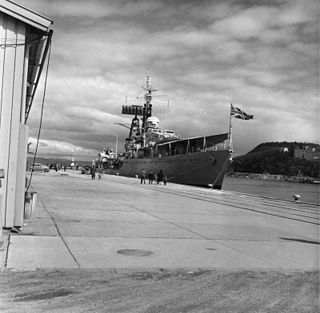
HMS Crossbow was a Weapon-class destroyer of the Royal Navy that was in service from 1948 and scrapped in 1972.

HMS Roebuck was an R-class destroyer of the British Royal Navy that saw service during World War II. She was the fifteenth ship to carry this traditional ship name, after a small deer native to the British Isles, which was used as far back as the reign of Queen Elizabeth I.

HMS Rocket was an R-class destroyer of the Royal Navy that saw service during Second World War. Built by Scotts Shipbuilding and Engineering Company in Greenock, Scotland, she was launched in October 1942 and commissioned in August 1943.

HMS Relentless was an R-class destroyer of the Royal Navy that saw service during World War II. She was later converted into a Type 15 fast anti-submarine frigate, with the new pennant number F185.
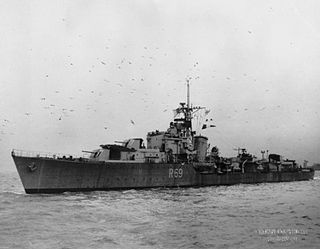
HMS Ulysses was a U-class destroyer of the British Royal Navy that saw service during World War II. She was later converted into a Type 15 fast anti-submarine frigate, with the new pennant number F17.

HMS Undine was a U-class destroyer of the British Royal Navy that saw service during World War II. On 27 March 1945, HMS Undine detached from RN Fast Carrier TF57 to rescue the airmen of a downed RN TBF Avenger aircraft also rescued a USN Corsair pilot adrift for two days south of the Sakishima Gunto in the Philippine Sea.
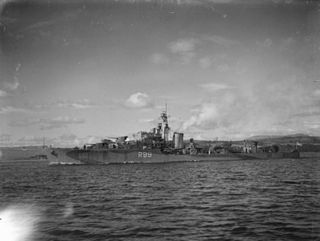
HMS Urchin was a U-class destroyer of the British Royal Navy that saw service during the Second World War.
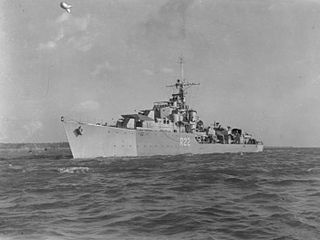
HMS Ursa was a U-class destroyer of the Royal Navy that saw service during the Second World War. She was later converted into a Type 15 fast anti-submarine frigate, with the new pennant number F200.

HMS Venus was a V-class destroyer of the Royal Navy that saw service during the Second World War. She was built by Fairfield Shipbuilding and Engineering Company, of Govan, Scotland and launched on 23 February 1943.

HMS Vigilant was a V-class destroyer of the British Royal Navy that saw service during World War II.
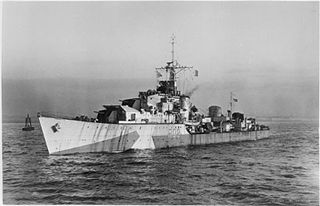
HMS Zest was a Z-class destroyer of the Royal Navy that saw service during World War II.

HMS Wizard was a W-class destroyer of the British Royal Navy that saw service during World War II.
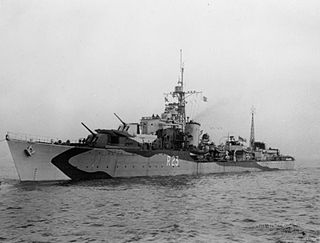
HMS Teazer was a T-class destroyer of the Royal Navy that saw service during the Second World War. She was later converted to a Type 16 fast anti-submarine frigate, with the new pennant number F23.

HMS Tenacious was a T-class destroyer of the Royal Navy that saw service during the Second World War. She was built by Cammell Laird, of Birkenhead and launched on 24 March 1943.

HMS Terpsichore was a T-class destroyer built for the Royal Navy during the Second World War.

HMS Offa was an O-class destroyer of the Royal Navy which entered service in 1941 and was scrapped in 1959.

HMS Wessex was one of eight W-class destroyers built for the Royal Navy during World War II. Completed in 1944, the ship spent most of the war assigned to the Eastern and Pacific Fleets. She screened British aircraft carriers as their aircraft attacked targets in the Japanese-occupied Nicobar Islands, the Dutch East Indies and Okinawa.

HMS Obdurate was an O-class destroyer of the Royal Navy. She was built by William Denny and Brothers of Dumbarton, being laid down at their yards on the River Clyde on 25 April 1940, launched on 19 February 1942 and commissioned on 3 September 1942.

HMS Eggesford was a Type III Hunt-class destroyer of the Royal Navy. She entered service in January 1943, carrying out convoy escort, patrol and anti-shipping attacks for most of the rest of the Second World War. In 1957, she was sold to the West German Navy, serving as a training ship for the submarine weapons school until 1968.
This page is based on this
Wikipedia article Text is available under the
CC BY-SA 4.0 license; additional terms may apply.
Images, videos and audio are available under their respective licenses.




















